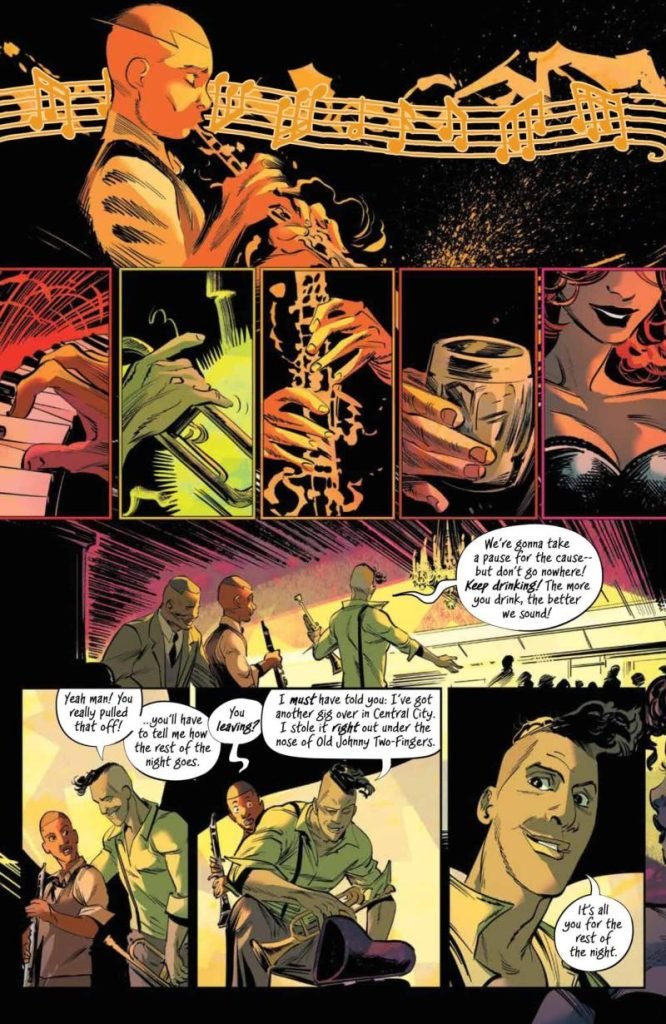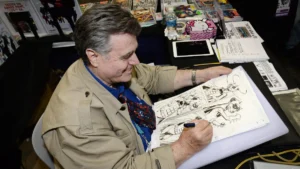Words: Kyle Higgins, Joe Clark
Art: Ramon K. Perez, Igor Monti
Image 2023
DARK WET PAVEMENT, shoe-leather rhythm, overcoat and fedora turned against the weather, horn case in hand, making your way here in the bowels of the city on the edge of the high life, poor as you have to be, you be rich soon if maybe you find that flow here among the dens and denizens, get a gig where you can blow, and glow. Man, you need a trumpeter?

I should be listening to beat-era jazz as I attempt to review DEEP CUTS, Issue 4, set in New York City in 1956, but I listen to the blues instead in a folksier, sombre mood, down country, where you don’t need no electricity, or friends, to bond with your instrument and your voice of woe.
Really, I can’t tell you anything about this story, because you have to dig it first-hand. Imagine those nineteenth century fantasy adventure authors who often opened their stories as if someone else is writing from an old manuscript just discovered, or many random sacks of notes set around the floor, telling strange tales of another time, other beings, and heroic challenges to survive, and perhaps after all find the eternal She concealed in the vast interior of the wilderness. This is the way writers Kyle Higgins and Joe Clark start the story of American jazz musicians in the 1950s. Artists Ramon K. Perez and Igor Monti make it feel like a bio-reel, absolutely real, like the best of those old adventure stories, where you gripped hold and hung on. The whole affect, in spectacular shots and powerful emotions, blew me away.
In the perfect-bound format, with a solidly complete single story, and extras in the back, I at first thought this title was a glamorous one-shot, until I discerned the number four in the stylized lettering. Happily, this is a six‑issue set, dramatizing successive decades of jazz, from the 1910s to the 1970s, situated by the same adventurous authors, with changing artists.
I had a ton more to tell about the decade of fear in 1950s America, criminalization of drugs, and mandatory sentencing that shackled judicial discretion in how to dispose cases in court; still a major issue today, criticized as then by judges themselves. We might also talk about health insurance and appropriate health care that could save innumerable lives through timely preventive care, which almost happened in the 1950s but for intransigent resistance in Congress, against labor rights, and any other measures designed for the public weal. We could touch on the composition, treatment, and astounding numbers of criminalized persons, segregated and imprisoned in our civilized nation.

But forget all that. You’ll get it.
Just go. Blow.
You can do just that, if you have a horn. At the back of the book is a page of sheet music for a tune “The Ancient’s Call Upon Us” by trumpeter Marques Carroll, for Deep Cuts #4, with a drum solo at the start. It takes two to get it right.
Typically, I never allow what the producers of a comic have to blurb about it to color my direct experience. Mostly, I feel the same way about jazz. Sure, I love some of the recordings, because like dance these days on film, there are things that otherwise you might never see again, and never remember; but for me, viscerally, jazz has to be live to feel it. The musicians telling their story here in an interview express the same kind of admiration, being there together at a singular moment, jamming their hearts out live, and gratefully recorded. In this case, the recording is better than anything I can do, and I have to step aside and look up in awe to let “The Other Side of Deep Cuts” in the back, facing the music page, solo everything you need to know about the message here.

“Every note is important. Change a single note and major becomes minor. With only two notes, you can imply a harmony, and with a harmony you can imply scales and modes, relationships and functions, possibilities and expectations of sounds to come. All of that is possible because of musical languages and traditions, forged one note at a time since the first human hit a drum.”
There it is. Just go. Find a companion, get the beat, and blow.


